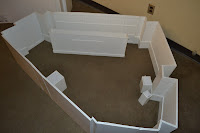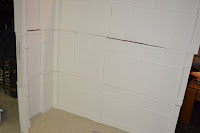ECU Sculpture
This blog is for East Central University sculpture students to interact with one another. Students will post images of their classwork and discuss / critique the work on an ongoing basis throughout the semester.

Thursday, December 8, 2011
Final Project-"Longing"
Wim Delvoye





In my last blog, I didn't include how I made my plaster sculpture. My first step was to research how to make and pour the cast. This took me weeks of reading books, watching videos, and calling supply companies. I decided to work with aginate, which is the material that covers the model and makes a skin. After covering the model with this goo, I secured the skin with cut pieces of burlap covered in plaster. This hardens in 5-10 minutes and then it was time to pull the skin off of the model which came off really easy. The edges of the skin pulled off of the plaster so I secured it with clothes pins (photo) I then poured the mixed plaster into the mold and let it set over night. The next day I cut off the burlap and the skin which took me hours and saw the plaster figure. I repaired the figure and attached it to the wood base with plaster. I painted the figure with three colors of acrylic paint. I went to the paint store and matched the colors with regular paint for the background. I added the tree branches because I wanted to tell a story with my sculpture. It's about the feminine identity associated with nature.
Sol Lewitt




"LeWitt was born in Hartford, Connecticut to a family of Jewish immigrants from Russia. His mother took him to art classes at the Wadsworth Atheneum in Hartford.[2] After receiving a BFA from Syracuse University in 1949, LeWitt traveled to Europe where he was exposed to Old Master painting. Shortly thereafter, he served in the Korean War, first in California, then Japan, and finally Korea. LeWitt moved to New York City in 1953 and set up a studio on the Lower East Side, in the old Ashkenazi Jewish settlement on Hester Street. During this time he studied at the School of Visual Arts while also pursuing his interest in design at Seventeen magazine, where he did paste-ups, mechanicals, and photostats. In 1955, he was a graphic designer in the office of architect I.M. Pei for a year. Around that time, LeWitt also discovered the work of the late 19th-century photographer Eadweard Muybridge, whose studies in sequence and locomotion were an early influence. These experiences, combined with an entry-level job as a night receptionist and clerk he took in 1960 at the Museum of Modern Art (MoMA) in New York, would influence LeWitt's later work.
At the MoMA, LeWitt’s co-workers included fellow artists Robert Ryman, Dan Flavin, and Robert Mangold. Curator Dorothy Canning Miller's now famous 1960 “Sixteen Americans” exhibition with work by Jasper Johns,Robert Rauschenberg, and Frank Stella created a swell of excitement and discussion among the community of artists with whom LeWitt associated. LeWitt also became friends with Hanne Darboven, Eva Hesse, andRobert Smithson.
LeWitt taught at several New York schools, including New York University and the School of Visual Arts, during the late 1960s. In 1980, LeWitt left New York for Spoleto, Italy. After returning to the United States in the late 1980s, LeWitt made Chester, Connecticut, his primary residence.[3] He died at age 78 in New York from cancer complications."
http://www.youtube.com/watch?v=3CV3iYNn0y0&feature=player_embedded
Auguste Rodin



 Auguste Rodin was a French sculptor who was born and raised in Paris. Despite his classical training and becoming well known in the late 19th century (and being world-renowned by the turn of the century), he never received academic recognition from the art world until after his death. His realistic style pulled away from the classical style that can be seen in other works of that time (more specifically Greek and Roman); exhibiting the natural features and musculature of his models, rather than over-exaggerating the figures and having a mythological or allegorical basis. This stray from conventionality stirred much controversy and rumors of cast making, which followed Rodin for some time until his exhibit of "Saint John the Baptist" which was larger than life-size and still showed his own personal style and technique. Several of his later pieces were inspired by events and people in his personal life, his mistress and colleague (Camille Claudel) in particular. She posed as a model for several of his pieces and was the source of the inspiration for the many depictions of lovers in passionate embraces. Long before knowing anything about Rodin, or even knowing that it was his work I was looking at, I was and still am greatly inspired by his work. Knowing that he became a success despite his challenges, only deepened that respect. In my opinion, the beauty of natural form and humanity he captured sets his work apart, which is a repeating theme in his work. Below I've also posted a brief biography from Answers.com.
Auguste Rodin was a French sculptor who was born and raised in Paris. Despite his classical training and becoming well known in the late 19th century (and being world-renowned by the turn of the century), he never received academic recognition from the art world until after his death. His realistic style pulled away from the classical style that can be seen in other works of that time (more specifically Greek and Roman); exhibiting the natural features and musculature of his models, rather than over-exaggerating the figures and having a mythological or allegorical basis. This stray from conventionality stirred much controversy and rumors of cast making, which followed Rodin for some time until his exhibit of "Saint John the Baptist" which was larger than life-size and still showed his own personal style and technique. Several of his later pieces were inspired by events and people in his personal life, his mistress and colleague (Camille Claudel) in particular. She posed as a model for several of his pieces and was the source of the inspiration for the many depictions of lovers in passionate embraces. Long before knowing anything about Rodin, or even knowing that it was his work I was looking at, I was and still am greatly inspired by his work. Knowing that he became a success despite his challenges, only deepened that respect. In my opinion, the beauty of natural form and humanity he captured sets his work apart, which is a repeating theme in his work. Below I've also posted a brief biography from Answers.com.Read more: http://www.answers.com/topic/auguste-rodin#ixzz1fw6jGlAs"
Wednesday, December 7, 2011
its done, Gaither

 I am so glad that it is over i cut myself some more and burned my hands,
I am so glad that it is over i cut myself some more and burned my hands, but the end of it i am so happy that it looks like it dose because i put a lot of work on these three different sculptures. My math felled on me again the pedestal are two to three times to big. The body parts and the tools didnt come out like i wanted them to look so i left them out. The one that won was the one that has three pedestals. I did fell bad about throwing it away seen i spent so much time and money on
but the end of it i am so happy that it looks like it dose because i put a lot of work on these three different sculptures. My math felled on me again the pedestal are two to three times to big. The body parts and the tools didnt come out like i wanted them to look so i left them out. The one that won was the one that has three pedestals. I did fell bad about throwing it away seen i spent so much time and money onit, but i really need the angry relies.




I forgot I needed to share how I made my pieces. First of all I bought 45 ft of copper wire, although when you look at the pieces together they do not seem to equal that amount, but they are there in fact. 2 big blocks of candle wax, boiling bags and an endless supply of cupcake holders. I used candle wax after melting and poured them into the holders for the form. These would become my heads for my mushrooms. After letting them dry but not completely I peeled away the paper layer. I would take the formed wax and drop it into the pot of boiling water, this smoothed out the tops and removed the ridges from the cupcake holders. I would then take one of the long copper rods and insert it into the bottom of the head. After I made sure they were standing nice and tall without the heads falling over, I continued. I like that I did not keep with one size, that I changed it up to have a nice variety of sizes. It was a crafty idea which became brilliant. I burned myself only a few times, but hey like they say if you don't get burned then whats the use....at least i think that's a saying. Apparently I've had one to many days without sleep.



















